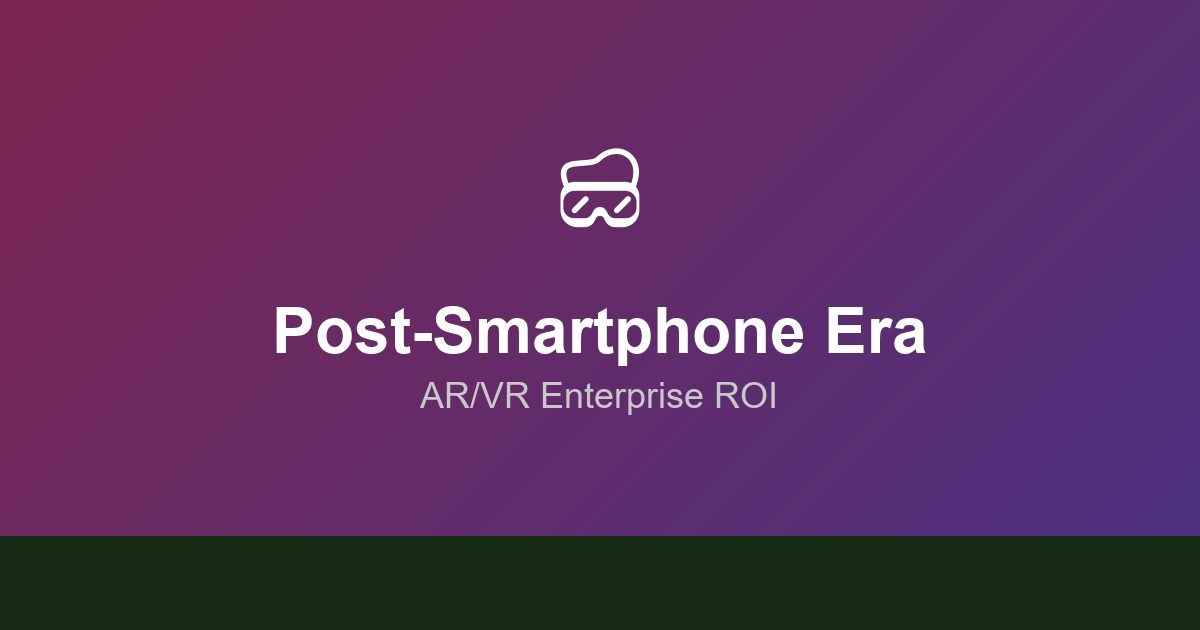The Post-Smartphone Era: How Zuckerberg's Vision Will Reshape Enterprise ROI

Mark Zuckerberg has declared a "war on the smartphone" [1]. While this provocative statement might initially sound like another consumer tech battle, for enterprise businesses and decision-makers, it signals a profound and imminent shift in the technological landscape. The question is no longer *if* a post-smartphone era will arrive, but *how* your enterprise will adapt to thrive within it. Is your organization prepared for a world where human-computer interaction transcends the handheld screen, directly impacting your operational efficiency, innovation cycles, and ultimately, your return on investment?
Mark Zuckerberg has declared a "war on the smartphone" [1]. While this provocative statement might initially sound like another consumer tech battle, for enterprise businesses and decision-makers, it signals a profound and imminent shift in the technological landscape. The question is no longer *if* a post-smartphone era will arrive, but *how* your enterprise will adapt to thrive within it. Is your organization prepared for a world where human-computer interaction transcends the handheld screen, directly impacting your operational efficiency, innovation cycles, and ultimately, your return on investment?
The Shifting Paradigm: Understanding the 'War'
Zuckerberg's declaration isn't merely about replacing a device; it's about ushering in an AI-first, spatial computing paradigm [2]. This vision, heavily showcased at events like Meta Connect 2025, centers on advanced artificial intelligence, augmented reality (AR) glasses, and immersive virtual environments. The goal is to move beyond the limitations of flat screens to a more intuitive, context-aware, and integrated digital experience. This represents a fundamental redefinition of how we interact with information and each other, akin to the monumental shift from desktop computing to mobile-first environments.
Historically, enterprises that swiftly adapted to such technological inflection points—from the internet revolution to the mobile explosion—gained significant competitive advantages. Those that hesitated often faced stagnation or obsolescence. The current trajectory suggests that the transition to spatial computing and pervasive AI will be equally, if not more, disruptive.

Enterprise Implications: Opportunities and Challenges
This emerging post-smartphone era presents both unprecedented opportunities for measurable business success and significant risks of failure for unprepared organizations.
Opportunities for ROI and Measurable Outcomes:
- Enhanced Productivity & Collaboration: Imagine immersive virtual meeting spaces where global teams collaborate as if in the same room, or AI-powered assistants providing real-time data overlays for field service technicians, dramatically reducing error rates and increasing first-time fix rates. These advancements promise tangible improvements in operational efficiency and employee output [3].
- Immersive Training & Development: Spatial computing offers a revolutionary approach to corporate training. Highly realistic simulations can be deployed for complex tasks, from surgical procedures to machinery maintenance, offering cost-effective, scalable, and engaging learning experiences. Measurable skill acquisition and retention rates can be significantly boosted, reducing training costs and accelerating workforce readiness.
- New Customer Engagement Models: Enterprises can forge deeper connections with customers through experiential marketing, virtual showrooms, and personalized support in spatial environments. This creates novel avenues for brand differentiation and customer loyalty, potentially leading to increased sales conversions and customer lifetime value.
- Data Visualization & Analytics: Interacting with complex datasets in 3D, manipulating models, and visualizing trends in an intuitive spatial environment can accelerate insight generation and decision-making, transforming raw data into actionable intelligence with clear ROI.
Challenges and Risks of Business Failure:
- Investment & Integration: The transition demands substantial upfront investment in new hardware, software, and infrastructure. Integrating these nascent technologies with existing legacy IT systems will present complex challenges, requiring careful planning and execution to avoid costly disruptions.
- Talent Gap: A significant talent gap is emerging in areas like spatial computing development, AI engineering, and immersive experience design. Enterprises failing to invest in upskilling their current workforce or attracting new talent will struggle to implement and leverage these technologies effectively.
- Security & Privacy: The pervasive nature of AI and spatial computing introduces new vectors for cyber threats and raises critical privacy concerns. Enterprises must proactively develop robust security frameworks and ethical guidelines to protect sensitive data and maintain user trust.
- Adoption & Change Management: Overcoming employee resistance to new workflows and ensuring practical utility beyond technological novelty will be crucial. A lack of clear use cases and poor change management strategies can lead to low adoption rates and wasted investments.
Strategic Imperatives for Enterprise Leaders
To navigate this evolving landscape, enterprise leaders must adopt a proactive and strategic approach:
1. Proactive Exploration: Begin experimenting with spatial computing and AI tools now. This isn't a future problem; it's a present opportunity for early adopters to define best practices and gain a first-mover advantage. 2. Pilot Programs with Clear ROI: Identify specific, high-impact use cases within your organization that can benefit from these technologies. Launch pilot programs with clearly defined metrics for success and measurable ROI targets. 3. Talent Development: Invest in continuous learning and development programs to upskill your workforce in AI, AR/VR, and spatial computing. Cultivate a culture of innovation and adaptability. 4. Strategic Partnerships: Collaborate with technology leaders like Meta, innovative AI startups, and specialized integration partners to accelerate your adoption curve and mitigate risks. 5. Focus on Value, Not Just Novelty: Prioritize solutions that address real business problems and deliver tangible, measurable outcomes. Avoid being swayed by technological hype without a clear path to value creation.

Conclusion: The Future is Spatial
Zuckerberg's "war on the smartphone" is more than a headline; it's a clarion call for enterprise leaders to recognize and prepare for the next wave of digital transformation. The shift to an AI-first, spatial computing world is inevitable and will profoundly reshape how businesses operate, innovate, and compete. Enterprises that strategically embrace this paradigm shift will unlock new levels of productivity, engagement, and profitability, securing their competitive advantage in the post-smartphone era. Those that fail to adapt risk being left behind, tethered to an increasingly obsolete mobile-first mindset.
Start planning your spatial strategy today. The future of enterprise success depends on it.
References:
[1] Mark Zuckerberg Just Declared War on the iPhone. *The Wall Street Journal*. https://www.wsj.com/tech/ai/mark-zuckerberg-just-declared-war-on-the-iphone-30163885 [2] Meta Connect 2025 Showcase A Coherent Vision for the Post-Smartphone Era. *CXOTrail*. https://cxotrail.com/artificial-intelligence/ai-insights-reports/meta-connect-2025-showcase-a-coherent-vision-for-the-post-smartphone-era/ [3] How AI assistants are changing the enterprise. *LinkedIn*. https://www.linkedin.com/posts/brendabown_ai-could-make-the-smartphone-pass%C3%A9-what-activity-7371020694748454912-kbZtReferences
- Industry research and analysis from leading AI technology providers and research institutions.
- Enterprise AI implementation case studies and ROI analysis from Fortune 500 companies.
- Market research reports from Gartner, McKinsey, and other leading consulting firms on AI adoption trends.
- Technical documentation and whitepapers from AI platform vendors and service providers.
- Regulatory compliance frameworks and guidelines for AI implementation in enterprise environments.
Ready to Implement AI in Your Enterprise?
Our team of AI experts can help you navigate the complex landscape of AI infrastructure and implementation. Book a free consultation to discuss your specific needs.
Book Free Consultation